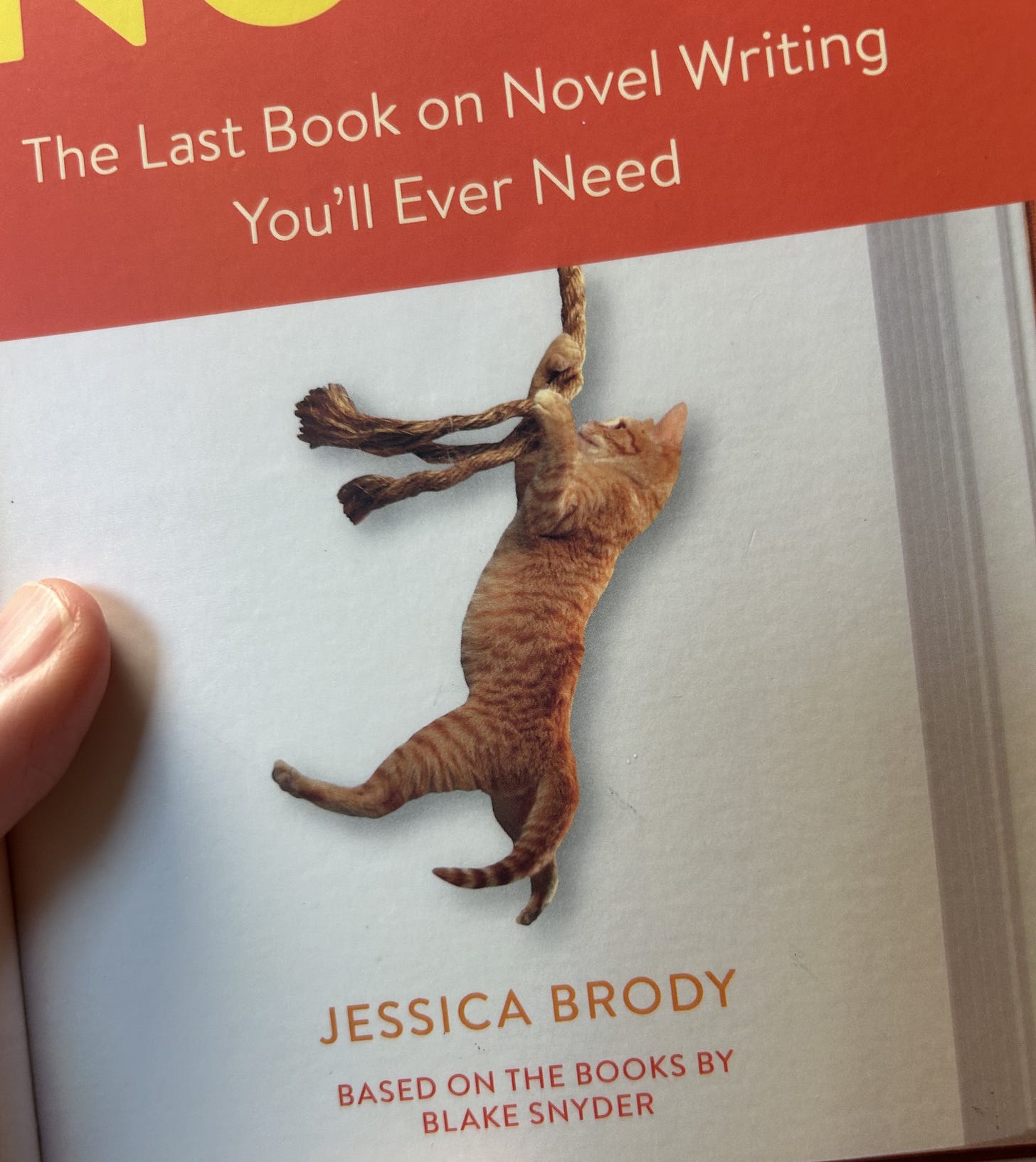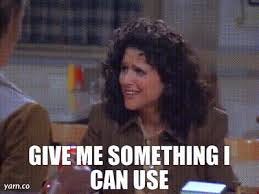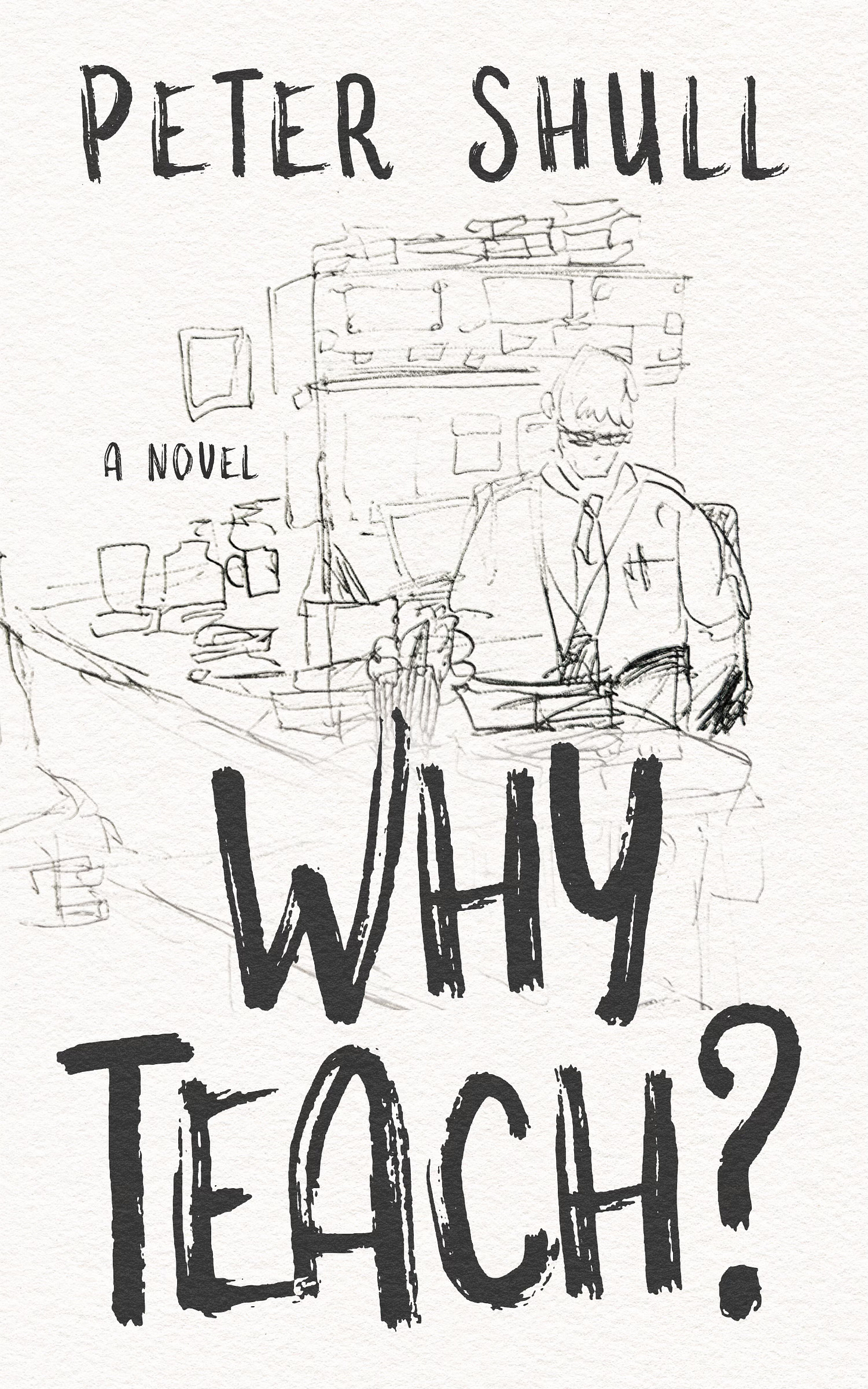Cover detail: Save the Cat Writes a Novel by Jessica Brody
Should you save the cat?
If you don’t know what I’m talking about, I know some writers who might envy you your ignorance. For my part, I don’t mind letting the furry little guy out of the bag.
“Save the Cat” is Blake Snyder’s “beat sheet” writing formula for screenwriters. It advocates for a 3-act, 15-part structure and takes its name from its audience-winning “beat” of having the protagonist do something admirable—like save a cat—early on in a film. Today there’s a popular adaption of the methodology by Jessica Brody for novelists. It’s titled Save the Cat Writes a Novel. Should you buy this book and subscribe to its model? Should you subscribe to any “beat sheet” that promises to make writing a novel as easy and formulaic as painting by numbers?
“Past me” would have been aghast that anyone might even ask the question. “Present me” is hesitant to naysay anything that makes writers think more carefully about story and structure. Today, I’m also someone who's read the book—and you know what? I think I’m a better writer for it. For me, the notion that a novel should have a functional structure and complete a narrative arc stands as a truth that should only be violated for a very good reason. As such, for me the question “should you read Save the Cat” isn’t just about reading Brody’s adaption of Snyder’s model. Rather, it’s shorthand for whether a novelist should study story, plot, and structure at all. Emphatically, I think the answer to that question is Yes.
The Sanctity of Story and Structure
The notion that a novelist or screen writer ought to study plot, story, and structure at first runs the risk of seeming a truth so obvious it shouldn’t even be broached, but in my recent experience, I don’t know that this is the case. In the realm of literary fiction, especially, it seems there’s a widespread and persistent stigma against studying structure and story at all. While most writers I know and see online are happy to discuss sentence-level writing, dialogue, characterization, and such writerly tools as character foils, irony, and word choice—and while we’ll merrily discuss artistic habits and talk about pens vs pencils and morning vs nighttime writing until last call at the literary bar—we seem to have a serious aversion to studying story, plot, and structure. These portions of the story ought to come most organically from the writer’s imagination, seems to be the prevailing attitude. Or even: literary fiction is fiction that is antithetical to formula. It’s the fiction that ought to be the most original and break farthest from established norms. Hence, I think, the stigma against studying plot and story… and also the superabundance of meandering, inconclusive, dull, and ultimately unsuccessful ‘literary’ novels.
To be clear: I’m a lit-fic fan. I’m not arguing that literary fiction should be tightly plotted, predictable, or dumbed-down to appeal to a broader popular audience. I’m also not insisting on clear, simplistic story arcs or clear, happy resolutions. And I’m not advocating against ‘quiet’ stories. I am, however, saying that I’m tired of literary writers and literary presses using the excuse it’s literary to justify books that are boring, self-indulgent, narratively unsatisfying, inconclusive, and, I think, unsuccessful as works of art. I’m also, then, making an aesthetic argument—joining several of my literary forebears in doing so; coming up against several other literary minds who would disagree: I’m arguing that a novel is, by its nature, a narrative art, that story is necessary, and that story revolves around character, has stakes, and has at least some semblance of a coherent cause-and-effect chain of events. Ideally, I think, characters are put into positions during which they have opportunities to change. Novels can meander; they can include significant ‘person vs society’ or ‘person vs nature’ qualities; significant social commentaries and criticisms can and often should be included—but a novel, quiet or loud, is largely an investigation of a single character or small group of characters as they face upheaval or difficulty.
What’s more, whether consciously or un-, readers open novels hoping to find characters encountering ‘hard’ situations. We want to experience hardship, we want have our hearts race a little bit, and we want to do these things vicariously from the comfort of our living rooms. These hardships need not be brutal winters, physical assaults, thefts of great works of art, or ticking time bombs; in Jane Austen’s fiction, I get bent out of shape when someone perfectly deserving doesn’t get invited to go on a carriage ride. What matters here is that, even if the novel takes place in outer space, readers get to experience conflicts at least somewhat analogous to the conflicts of their own lives so as to be better prepared to encounter them. And conflicts are interruptions of status quo situations that result in either new status quos or unexpected returns to the original status quo.
Elaine Benes doesn’t like The English Patient. See ~1:38—to 2:11.
In the simplest, most near-algebraic manner I can put it:
Status quo → period of challenge, agitation, tumult, or upheaval → new status quo1
Or, you know, draw a Freytag’s triangle2.
All of this isn’t to say that novels cannot self-consciously break from a character-and-story-focused format, of course, but it seems to me that when successful novels do break with traditional storytelling approaches, they do so self-consciously and are able to do so because they are familiar with existing storytelling norms. There can certainly be novels that go off on long tangents, “novels of ideas,” or “novels in stories,” and I, personally, am often interested in disparate characters and events that may have more clear thematic unity than the pursuit of a traditional chronological plot… But far too many books that aren’t successful from a character-based narrative perspective come across, to my thinking, feeling like cheats: “shortcut” novels that avoid the hard labor of investigating characters, situations, and conflicts; novels which aren’t structurally interesting for their avoidance of traditional narrative structure, which cover for their deficiencies with a veneer of language, spectacle, and some relative consonance or dissonance between what readers might reasonably expect and what they get. Too often of late, the point of these narratively unsuccessful books has been to shore-up ideological positions in our national dialogue with a series of illustrations populated by stock characters. Aesthetically speaking, I don’t think this is very artful. It strikes me, instead, as turning the novel into a simplistic tool—a cudgel—for propaganda, and I think this is a lousy thing to do to the novel as an art form. To put a sharper point on all of this: I don’t think a novel should be a place where we air merely air our grievances and point out how unjust the world is; I think a novel should be a place where characters work to find their places or their paths in an imperfect world, or don’t, and I don’t think that approach to the novel is quite the same as the above-described former.3
So back to Save the Cat Writes a Novel:
Should you read this book? I think you should. I read it and found it to be full of great lines that helped me think more deeply about plot, story, and structure. Did I follow the Save the Cat “beat sheet” to write my first novel, or the second and third I have been drafting? I did not. But some of the arguments mounted by the book and some of its pithier lines have stuck with me. In fact, though none of the books I have written explicitly follow the “save the cat” model, thinking about the model as I have written—and thinking about it as I have gone back to reread favorite novels and plays4—has helped me become a better writer. Thinking about characters’ wants versus their needs has been helpful to me. Thinking of Act II of a novel as the antithesis of Act I—or even possibly antithetical to Act I—has been helpful to me. Thinking of ways my protagonist might fix their problems the wrong way has been helpful to me. Considering the possibilities of false victories and false defeats has been helpful to me.
…
But perhaps I’ve failed to convince you. No, my art will be original, you might be saying. I won’t be working with any preexisting forms.
If so, great. I’m fascinated. What’s it going to look like, your never-before-seen structure? Will you sketch something up? Draft something out? Or will you wander aimlessly in the forests and deserts of your prose until you discover something new purely by trial and error?
I use a well-worn example when I say that Shakespeare borrowed most of his plots. To name four great, famous books of the last thirty years featuring borrowed structures, I could rattle off One Thousand Acres by Jane Smiley (King Lear), On Beauty by Zadie Smith (Howards End), and Demon Copperhead by Barbara Kingsolver (David Copperfield). Percival Everett’s James starts off making good use of some borrowing from The Adventures of Huckleberry Finn, then takes some leaps from that book’s plot, structure, and episodic style. There are surely many more. This brings me to a point: I don’t know that that an original structure is what makes a thing artful or original, but I do know that art requires structure, and I don’t know that structure is something we as novelists can just happen into in the course of our ‘pantsing’ sessions when we sit down to write. I think it needs to be planned.
I have more to say about structure in perhaps another essay or six or ten (I cut about 2,000 words from this one), but this feels as if I’ve written enough for the time being. If you want to see some of my structural work in action in short story form, feel free to check out my stories Cheaters, Prague, or Ornamental Pond Fish of Southwest Kansas. If you want to read my novel, the first chapter of which I’ve shared on Substack here, it’s available online wherever books are sold. Stay tuned, I’m thinking about unveiling my second novel Komojo! in serial format soon, but the possibility of submitting it to
’s “Pilcrow” Substack serial competition is of some interest to me, and perhaps some of my readers ought to consider submitting their own books.Until next time,
Peter
Peter Shull is a Midwestern novelist, essayist, short story writer, and educator. To support him, buy his novel Why Teach? about a young high school teacher navigating the treacherous waters of small town life and the damning consequences of high-stakes testing. It’s available at Bookshop.org, Barnes & Noble, Amazon, Kindle Store, and Kobo.
It could perhaps go unsaid, but I’ll say it anyway: the ‘new’ status quo can simply be a return to the old status quo. My favorite example of this might be John Cheever’s short story “The Cure.”
As both a writer and a high school English teacher, I’ve come increasingly to a love/hate relationship with Freytag’s triangle. It can be far too simplistic—can misrepresent the subtleties and complexities of good structures—but it’s hard to deny its efficacy as a starting point for thinking about story and structure. If filled out fulsomely—and used to argue, say, about where exactly the climax of a work is, it can be a powerful tool.
I recognize that this is an aesthetic argument. As an educator, I’m open to many aesthetics; as a reader and writer, my personal viewpoint narrows. There’s perhaps no disputing taste, but if you’d like to, feel free to hit me in the comments, eh?
Did Shakespeare follow a “Save the Cat” model in his plays, which were all comprised of five acts? He did not. But did he clearly make use of existing structures and formulae, even to the extent of mocking those existing structures? He did! And he could never have gotten to the point of “mocking” and “playing with” those structures in interesting ways if he hadn’t learned them so well to begin with. To make an educator’s analogy for all of this: I don’t hope that my students grow up to write a lot of five-paragraph essays, but I do recognize that a 5-paragraph structure is a helpful stepping stone on the way to more interesting and original ways of organizing essays. Perhaps a writer planning a long career would do well to write some early ‘practice’ novels using established patterns and structures.






I quite enjoyed reading this! Thanks for sharing your thoughts with us.
As a “plotter” and structure nerd, I’m already sympathetic to a structure-based approach.
In my work in design, I’ve seen that many of the most effective patters work because they fit the way human brains perceive and process information. I have a hunch that story structures that “work” do so because of this human fit. (Sort of like how an ergonomic chair better supports your lower back — the chair is designed based on human tolerances.)
I especially liked your footnote about writing practice novels:
> “I don’t hope that my students grow up to write a lot of five-paragraph essays, but I do recognize that a 5-paragraph structure is a helpful stepping stone on the way to more interesting and original ways of organizing essays. Perhaps a writer planning a long career would do well to write some early ‘practice’ novels using established patterns and structures.”
There’s a parallel here with pottery. When you are starting out, the first form you learn is the cylinder. It’s the basic shape upon which all the others — cups and vases and teapots — are formed. Or think of leaning to play scales on a musical instrument. The point isn’t the cylinders themselves or the scales any more than there is a point in writing a formulaic, paint-by-numbers plot. But, once you get that foundational form “in your fingers” so to speak, you can move on to double-walled vessels (pottery) or arpeggiations and flourishes, etc. (music).
You may do so much improvisation that the original underlying cylinder is no longer visible, but the know-how that came from mastering the basic form still informs your choices and helps you avoid building a pot that will fold in on itself and collapse.
A last, random thought that occurred to me as I was reading your piece: perhaps the best literary fiction is a bit like jazz — an acquired taste for a narrower audience with a developed palate. Can someone learn to play improvisational jazz purely by ear and feel? Absolutely. But you will still develop a broader range and have better control if you learn the theory and practice your scales as well.
As I said before, thanks for sharing with us. You’ve got me thinking!
I can tell I'm about to write a response post to this from the second line...